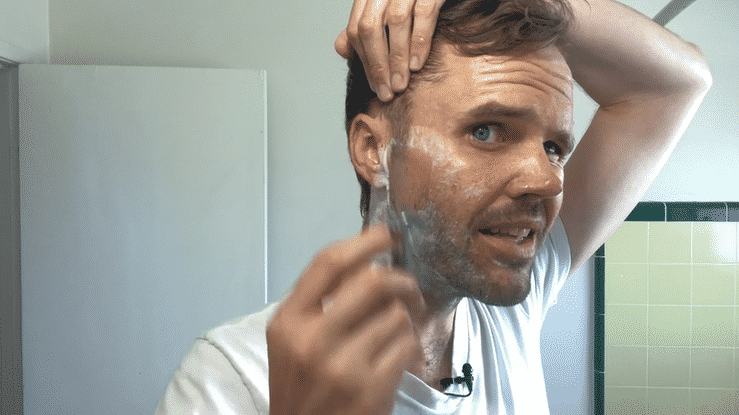Shaving is a daily ritual for many of us, but the art of shaving with a safety razor is a skill that seems to have been lost in time. Today, I want to guide you through my step-by-step process of how to shave with a safety razor, as I demonstrated in my video, “Carleton Shaves”.
This video is a long one, so I’ve used Ai to analyze it’s content, and turn it into a blog post. Now you can get the full 37-minute experience, in just the time it takes to read 700 words!
Alternatively, you may start a chat session with this Ai-powered chatbot I made. Click the little icon in the right-hand corner of the screen.
Safety-Razor Shaving Equipment
The quality of tools used for shaving can make a significant difference to the final result, as well as the overall enjoyment of the shaving exprience. I use a shaving soap from a brand called Royal Appleberry, which I’ve found leaves my skin without razor burn. I also use a Parker Safety Razor – 100% Silvertip Badger Men’s Shaving Brush, although I do have concerns about the sourcing of the hair for the brush.
The safety razor I use is the Merkur Mk34c Double Edge Razor with Heavy Duty Short Handle. This short-handle version Merkur safety razor is a simple, yet effective tool that allows for a close and precise shave.

Merkur also make long-handle versions of their safety razors, or you can just go to your local antique store and see if they have any existing safety razor handles you can buy. Many 100-year-old antique safety razors can still accept a modern-style razor blade.
The design of a safety razor is such that the top piece can be unscrewed from the bottom piece, making it easy to replace the blade when necessary. I’ve been using the same razor for about a month and it’s time to change it. I use BIC Chrome Platinum Double Edge (DE) Razorblade – 100 Blades. I bought the pack for $30 in 2015 and have only used about 40 of them.
When it is time to change your safety razor blade, it’s important that you safely dispose of the old razor blade. It’s not just about keeping your bathroom tidy; it’s about ensuring that we don’t pose a risk to sanitation workers or others who might come into contact with our waste.
Pre-Shave Routine
Before I start the process of shaving with a safety razor, I always prepare my skin. I’ve found that applying a bit of olive oil to my face helps to reduce friction, which in turn helps to prevent any potential razor burns. This is backed by a study that found olive oil had beneficial effects on the skin barrier and could be used as an emollient in skincare products.

I also wet my face with warm water. I use a Marvy Rubber Shaving Mug which is made of hard rubber so that it won’t shatter if I drop it. I also use the water in the mug to clean the razor, instead of constantly running water from the faucet. The warm water helps to soften the hair and open up the pores, making it easier for the razor to cut through the hair.

Shaving With a Safety-Razor
When it comes to the actual shaving process with a safety razor, I apply the brush to the soap and work up a lather. Once enough soap is on the brush, I then circularly move the brush on my face to effectively distribute the soap. I hold my skin taut while shaving, so that the razor doesn’t have to do as much work.
Shaving requires mindfulness and care. The weight and heft of the safety razor itself will give you a greater tactile understanding of the shaving process. Since there’s only a single-blade in a safety razor, you’re able to get much more direct feedback on the shaving process.

Anecdotally, I’ve also noticed the habit of opening my mouth while concentrating on a task, and that reminded me of the theory that biting one’s tongue helps to free up the brain to concentrate. While you shave, you’re engaged in an act of mindfulness, which means shaving can be seen as a form of stress reduction, if you enjoy it.
Post-Shave
After shaving with a safety razor, I clean my face with cold water, which can help to reduce inflammation and swelling, both of which help to soothe the skin after shaving. Whenever I do accidentally knick myself while shaving, I like to take an opportunity to reflect on the amazing ability of our bodies to heal and maintain homeostasis.
Conclusion
Learning how to shave with a safety razor can seem daunting at first. With practice and the right tools, using a safety razor can become a satisfying part of your shaving routine.
Remember, the key to a good shave is patience, precision, and the right tools. So, if you’re wondering how to shave with a safety razor, just follow these steps and you’ll master the art only a few weeks. Happy shaving!

